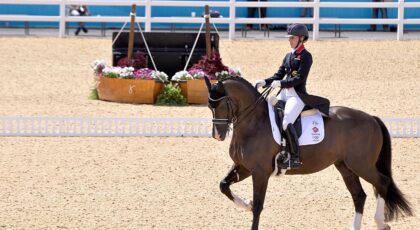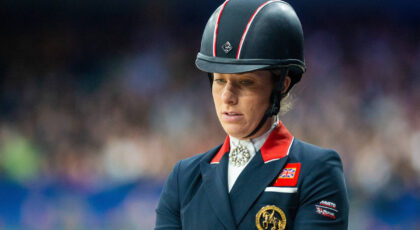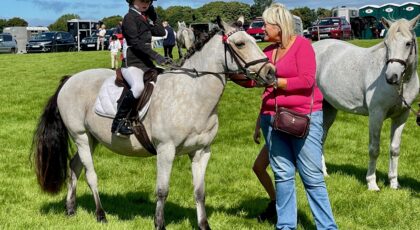Props might be the last thing you think of when it comes to schooling your horse, but sometimes they can be just what you need to add a little variety and interest to your time together in the ring. Incorporating a simple traffic cone can be a surprisingly easy way to improve everyday exercises, bettering your horse’s focus and his response to the aids, while sharpening your own timing and accuracy. In this particular exercise from Training and Riding with Cones and Poles by Sigrid Schöpe, you’ll also work on your coordination and dexterity.
* * *
You need a traffic cone that is open at the top, and a stick of some kind with a length of thin rope about 6½ feet (2 meters) long tied to one end. A stiff dressage whip or horseman’s stick (there are many kinds available on the market) works perfectly.
Note: There are different ways to hold the reins in one hand, depending on your discipline and preference. In this exercise, use the method you are most comfortable with.
What the Exercise Looks Like
Place the cone so it is in an appropriate position to be the middle of a small volte or circle. Next, position your stick or whip, complete with the length of rope, into the top opening of the cone. The rope should hang free.
Ride up to the cone and grasp the free end of the rope. Ride out as far as the rope allows you. Holding the end of the rope in your inside (inside the circle) hand, try to ride an even, round circle around the cone. The rope should be stretched taut but the stick should not come out of the cone and the cone should not fall over.
The difficulty lies in relying on your weight and leg aids while trying to organize the circle at the end of the rope. Try the exercise in both directions. It looks easier than it is, as you will see!

How to Do It
Your weight and leg aids are of the utmost importance in this exercise. Use the reins as little as possible. Hold your horse on a small volte or circle with weight aids (shifted to the inside) and leg aids (outside leg slightly behind the girth, inside leg at the girth). Correct only minimally with the hands. Use your body in the turn as you look toward the cone and concentrate on keeping the stick in it and the cone upright.
Those who ride Western may find this exercise a bit easier, since they and their horses may be accustomed to neck-reining (the horse reacts to the touch of the outside rein on his neck). If you are unfamiliar with riding one-handed, hold the reins in whichever hand is on the outside of the circle (the inside hand holds the rope) between your thumb and the index finger or between your index and middle finger. The hand should remain quiet; it should not cross over the horse’s mane. Even if your horse does not neck-rein, it is possible to send signals through the reins through sensitive flexion and giving of the fingers. For example, a yield of one rein is possible by stretching or loosening the fingers on that rein.
When you have a good feel for the exercise and your horse is bending well, try it at the trot. Your horse will try to make the circle around the cone larger. The faster the pace, the more difficult it is for him to maintain the bend on the tighter turn. To prevent your horse from evading to the outside so he can travel on a larger (easier, for him) arc, bring your outside leg back to keep his hind end in line and control the outside shoulder with the outside rein. Remember: Never pull on the inside rein to make a circle smaller as it blocks the horse’s inside hind leg from stepping well up and under him, and the exercise becomes useless.
Some find this exercise more successful when they sit the trot. It depends on you and your horse, however, so try it both sitting and posting.
Stick in the Cone Variation
Another and more difficult variation of this exercise is to hold the stick in your hand and try to get it, or the end of the rope, in the opening at the top of the cone as you walk by. At the beginning you can halt your horse beside the cone, but challenge yourself to get it at the walk. This is difficult enough on a straight line, but you can also ride a circle around the cone as just described.

Sometimes what seems like just a playful little game can actually be very difficult. With a little creativity, you will see that training can be fun for both you and your horse!
* * *

This excerpt from Training and Riding with Cones and Poles is reprinted with permission from Trafalgar Square Books.




 June 19, 2018
June 19, 2018 




























